Menus
- 4-T single cylinder, 499 cm3, 27.2 hp at 5,250 rpm, 41.3 Nm at 4,000 rpm, 195 kilos, € 5,985
- A timeless machine with inimitable charm
- Discovery
- In the saddle
- Engine and transmission
- In the city
- On motorways and main roads
- On departmental
- Part-cycle
- Brakes
- Comfort and duo
- Consumption & autonomy
- Conclusion
4-T single cylinder, 499 cm3, 27.2 hp at 5,250 rpm, 41.3 Nm at 4,000 rpm, 195 kilos, € 5,985
A timeless machine with inimitable charm
Welcome to the Royal Enfield paradox. A brand that was moribund ten years ago (30,000 motorcycles per year) and which today releases the same quantity of machines from its factories every two weeks. Yes, calculate, it is close to 700,000 annual units. A planetary commercial success and a strategy of conquest which has only just begun, the next 410 Himalayan and 750 twin (announced for the EICMA show in Milan) being called to be followed by many other novelties. And yet, the brand has its detractors: basic or even retrograde technology (what, there is no traction control, shifter or four engine maps, it’s a scandal!), Modest power, performance objectively limited, although more and more in tune with the era of all repression and the society of the radar that we live more intensely every day thanks to the horde of perrichonophile tarts that rule us. Futile arguments that do not go against the growing success of these machines.
Royal Enfield, we are starting to know a little about the Den: last year we offered you the test of a Classic Santal in Euro3 version as well as, more formerly almost ten years ago, a black Bullet Standard. For the anecdote, the latter is my personal bike, with which I covered more than 13,000 kilometers (of happiness, with a trip to the edge of the Sahara as a climax and with like all worries a burnt night light bulb, turn signal screws to tighten and a dead battery). Perfect to be able to compare and gauge the merits of this Euro 4 version, no ?
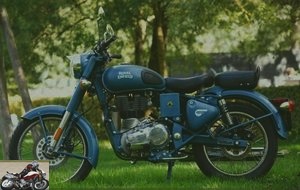
Discovery
The great thing about the Royal Enfield is that it doesn’t have to go to any great marketing effort to fit into neo-retro or pseudo-vintage fashion. It is legitimate since its DNA goes straight back to the 1940s. This is the case of the Bullet Standard (also passed Euro 4), whose shape of the frame, the paint and the logos are in all points identical to those of the 1949 vintage. The Classic version and its multiple variations (in chrome or matt, without forgetting the Redditch newly arrived on the market), manages to offer different personalities at little cost, always with this surprising question from onlookers: "But what year is it?" ". A piece of advice: answer "1953", that will make them happy.
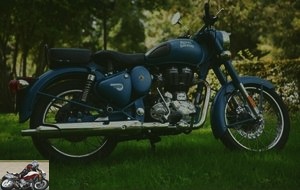
The appearance of the disc brake at the rear is the most visible of the novelties linked to the transition to the Euro 4 standard. It also comes with an ABS unit, which is now compulsory. Another development, the passenger seat now standard. The engine has of course been adapted to pass the pollution standard with a new catalyst and adapted mapping. Likewise, the electrical harness has been revised and the fuel cap is more watertight. Finally, the typography of the meter has changed and an ABS indicator has appeared. Likewise, the lights are now automatically switched on.

In the saddle
Compared to the Bullet Standard, the changes are minor. The knee flu forces to spread the legs a little more, in all honor, however. The single-seater saddle (and its pouf) generates a slightly different perception, but we are really there in the nuance.
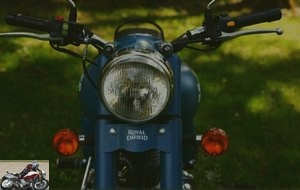
The driving position is natural, slightly relaxed, with a position of the feet a little forward, to which you get used very quickly..
Up front, one cannot say that one is overwhelmed by the amount of information. A speedometer (with a real needle, like in the old days!), A few indicator lights (illegible, alas), do we really need more? No tachometer anyway, because the Classic is driven by feeling and by ear. Of a daily totalizer, perhaps? Oh yeah, that would be good ….
Finally, we appreciate the presence of a kick, always useful if the drums do their own. In addition, the start is quite easy, especially as the mono is weakly compressed (8.5: 1).

Engine and transmission
A catalyst and a different mapping, this is what distinguishes the good old single-cylinder long stroke (84 x 90 mm) from its Euro 3 version. at 27.2 now. If this argument scares you off, it’s because you’re not ready for the Royal Enfield philosophy..
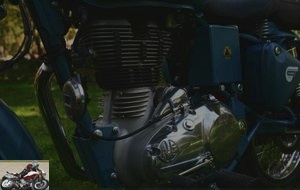
The gearbox is 5-speed and you should know that the driving conditions in India are such that the gear ratio is very short from the outset. It is therefore in the interest of extending the transmission ratio of one or two teeth at the level of the gearbox output pinion in order to gain a bit at cruising speed (and above all to delay the threshold where vibrations appear), which the engine torque allows you to cash in without flinching.
In the city
Where are the 195 kilos? It’s very simple, outside of the maneuvers, you don’t feel them. But then not at all. It’s quite simple, the Royal Enfield Classic is almost as agile as a 125, it weaves its way between the cars in a subtle mix of ease and nonchalance, aided by the flexibility of the engine, able to resume at 40 km / h in 4th without flinching (and even at 60 km / h in fifth), which is absolutely remarkable (so try doing this with a Yamaha 500 XT, for example!). The turning radius is very good, which does not spoil anything. On the other hand, the steering lock remains on the steering column and there is no space to carry an anti-theft device: that said, a pair of leather saddlebags go very well to the Royal Enfield..
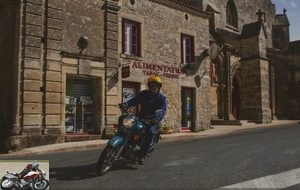
On motorways and main roads
It’s clearly not his thing. Nose in the handlebars, you will manage to take 140 km / h meter but the vibrations of the single cylinder are destructive and you will end up taking the engine in the face. To be avoided as much as possible therefore: a Royal Enfield is to be fully savored by having time to live. Of course, given the modesty of performance, stability is not really an issue..
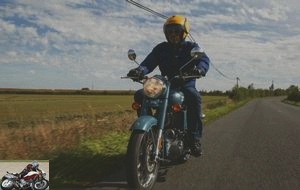
On departmental
"Where’s the happiness?" Sang Christophe Mae! Ben, there he is! If you take the time to savor things, take a ride in a Royal Enfield on a small country road, it is simply happiness in a bar. Obviously, you should not look for performance, not try to attack the turns like a starving man, but to enjoy the road, the life and the landscape, it is difficult to do better..
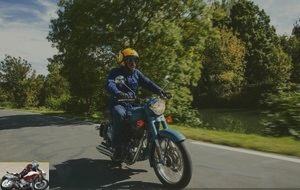
However, compared to the Euro 3 version, the engine has gained in flexibility and range of use, but has lost a bit in character by being more linear than in the past. It is true that my test bike only had 2000 kilometers on the clock and that the engine really breaks free a little later..
For the rest, we cruise at low speed, carried by the torque of the single cylinder and the machine is forgotten. Except on the cafe terrace of a small village lost in the countryside, where there is no better way to link conversations..
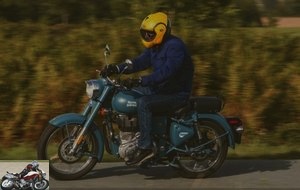
Part-cycle
Nothing fancy here and nothing new either. Obviously, the fork (35mm in diameter and 130mm of travel) is not adjustable and with a bit of nitpicking, you could say that the rear shocks are relatively poor, even though they are adjustable in 5 levels of preload and travel. over 80 mm. The tires are Avon RoadRider, very correct in the dry, necessarily modest in size (90/90 x 19 front, 120/80 x 18 behind).
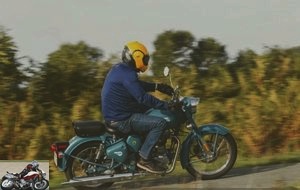
Brakes
There are two ways of looking at it: objectively, a Royal Enfield Euro 3, it does not brake that great and yet, given the performance and given the driving style (rolling, anticipating, using the generous engine brake), no one is complained of braking. The good news is that the braking of the Euro 4 version is really better: if the front (280 mm double piston disc) is still weak, the 240 mm single piston rear disc is now significantly more powerful. than the drum of Euro 3. Another good point: the ABS cell can be triggered if you insist, but it quickly regains its senses and braking, suddenly, it is effective. Suddenly, we tend to brake by favoring the rear.
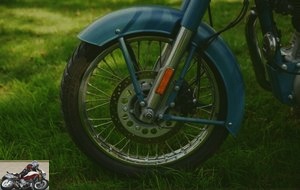
Comfort and duo
Compared to the Bullet Standard, the saddle is different: it is better for the rider, a little worse for the passenger and we must not forget that the Royal Enfield remains a motorcycle of a small size. However, in India, she carries families of 4 without flinching !

Consumption & autonomy
This is another strong point of this machine: the consumption is ridiculously low and will in most cases be between 3 and 4 l / 100. Enough to easily envision 350 kilometers of autonomy with the 13.5-liter tank, which is always good to take in these times of expensive oil. On the other hand, the tank cap no longer locks with the key..

Conclusion
The Royal Enfield is the art of affording the luxury of being out of fashion: because she does not force herself to appear, she knows better how to coat her being with a dress with old-fashioned charm and yet more current. than ever. It was said that the standards would condemn air-cooled engines and yet the tumbled single cylinder passes Euro 4 standards by being more flexible than ever, even if the character has left some feathers there (which will be easy to find, if necessary).
Certainly, at nearly 6000 euros, we have more efficient and much faster A2 machines! But do they have as much charm as the Royal Enfield, which also takes care of its budget by running costs at the level of daisies: it is not fuel, nor tire wear, nor insurance, nor maintenance (valve adjustment by hydraulic valve lifters and an oil change every 6000 kilometers) which will ruin you. There remains the pleasure of riding this historic machine and forcing yourself to take the time to be able to fully appreciate it..
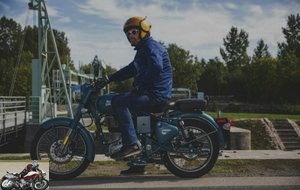
Strong points
- Timeless look
- Inimitable charm
- Ease of driving
- Ultra reasonable running costs
- Smooth motor
- Ballerina agility
- Allows you to keep your license points
- Beautiful matt blue color !
- A2 license approved
- Rear brake significantly more powerful than in the past !
Weak points
- Objectively limited performance (but for real, who cares a little)
- Unreadable dashboard lights
- Fuel tank cap that no longer locks with a key
- Smooth motor, but more linear
The technical sheet of the Royal Enfield Classic
Test conditions
- Itinerary: a walk of a good hundred kilometers in the Poitevin marsh
- Motorcycle mileage: 2,000 km
- Problem encountered: none
The competition: Mash Five Hundred (although …)
Related articles
-
Royal Enfield Continental GT test
The Cafe Racer spirit and the joys of the single-cylinder combined in one motorcycle Single cylinder, 535 cm3, 29.1 hp at 5,100 rpm, 44 Nm at 4,000 rpm,…
-
Royal Enfield Meteor 350 motorcycle test
Entry-level, extra class Air / oil single cylinder, 349 cm3, 20 hp and 27 Nm, 191 kg full made, from 4.099 euros Royal Enfield commemorates its 120th…
-
Single cylinder tumbled, 499 cm3, 27 hp, 41 N.m, 187 kilos with full tank, € 5,785 A retro machine full of charm to rediscover the joys of everyday life…
-
Royal Enfield Bullet Standard Test
The time machine Born in Great Britain in the 1890s (and the offshoot of a weapons factory, hence the name of its models, Bullet), but Indian since the…
-
Royal Enfield Bullet 500 motorcycle test
Indian classic Virtually unchanged in 50 years, the Royal Enfield Bullet is the epitome of the motorcycle in its simplest form: two wheels, handlebars…
-
Royal Enfield 650 Interceptor and Continental GT test
Authentic (r) evolution Twin-cylinder in-line, 648 cm3, 47 hp and 52 Nm, 198 kg dry, double tubular cradle frame At the end of 2018, Santa Claus is…
-
Single cylinder, 411 cc, 24.5 hp at 6,500 rpm, 32 Nm at 4,000 rpm, 185 kilos, from € 4,495 A small, economical and versatile single-cylinder trail runner…
-
Moto Guzzi V7 Classic and V7 Cafe test
Decaffeinated cappuchinos In the footsteps of its history, Moto Guzzi resuscitates the myth of the V7 Sport with these two superb variations on the same…
-
Flat twin, 1170 cm3, 125 hp at 7,750 rpm, 125 Nm at 6,500 rpm, 244 kilos with full tank, from € 16,400 The world’s best-selling large displacement is as…
-
Royal Enfiel RE350 Brass Rajah motorcycle test
The Indian Bobber King of Brass 346 cc single cylinder, 19.8 hp, 28 Nm, 155 kg dry The customization of motorcycles has known for a decade a continuous…
Purchased 3 weeks ago, my opinion is as follows: Successful look and beautiful finish given its very modest price! Low power but compensated by a torque present from the low speed and in any case this bike is made for quiet cruising. So those nervous about the right grip will have to look elsewhere! Only downside: the rear suspensions which type very quickly and make the machine uncomfortable. Too bad because the fork is well cushioned …. Otherwise, despite its weight, it is easy to maneuver because the center of gravity is low. In short, a small motorbike that we will choose for a second fitment or if we are starting out with 2 wheels!
Aesthetics aside, For the same price I would rather take a 300ac 3995 euros voge
Or even better a Voge 300Ds 4395 euros. The endowment in accessories as in suspensions is much higher and the engine
With its 27 CV it is 30km / hour ahead.
20 chwo, you’re talking about a meteor, I mean, it’s more sales than anemic lung
Certainly, but that does not change the geometry of the chassis, nor the driving position.
That is why
A new-Bullet what, and if there are a few more cm3 for the road, I do not say no.
Too bad to make A2 bikes that you can’t use everywhere. I have a 190-kilo 34hp mono flanged 650, maneuverable and can do a few sections of the motorway at 140km / h just in case. And the rest of the time cushy on the road and even as a duo. There you do the turkey in town and you hang around every climb, leaving darling at home. top
@Meuldor: the Meteor is designed for the Indian market.
Otherwise, at RE there is the 650, which is A2 without bridle.
That’s very good … For little Indians who only have 2% of highways on their network! To slalom between the cows … But for us ?? What do we do with a 20 hp blaster ??? For the city we already have plenty of 125 more economical …
We also sometimes have the chance to try out exceptional motorcycles!
I have no doubts about the quality of the work from a mechanical point of view, but as regards the look, it’s seen and reviewed…
Nevertheless, the article and the photos are very nice!
The art of transforming a beautiful motorcycle into an ugly …
Always so fascinating these tests of these technological curiosities of the time. Thank you.
384hp per liter of displacement, and without supercharging!
a 50cm3 would be enough for me, in fact.
well maybe it’s a little too sharp to put a vario in it, or maybe with an 18 speed gearbox?
It’s crazy how this style of riding, with the shoulders still above the tank, seems "old school" nowadays, whereas it was the norm back then. We got so used to seeing modern pilots caressing the vibrators with their shoulders, that we have the impression that it has always been like that..
To come back to this sublime Elf, I don’t know if it’s because they were the first motorcycles that made me dream when I was a kid, but I find that the trackers of the 90s really have something more.
Their design immediately triggers something in my brain, as I find it hard to be so ecstatic about a more modern model..
The Cagiva V593 in particular is absolutely sublime.